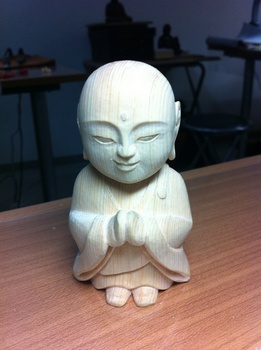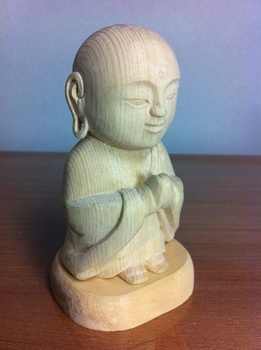2012-11-11 [Oilpainting]
There was a class today. It's been three weeks since I joined last time.
The following image is the latest one.
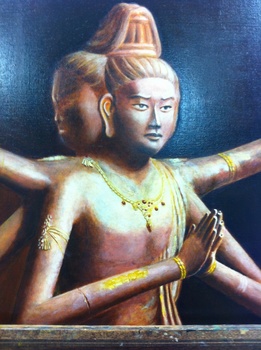
The following image is the latest one.

Ryoyu Fukui's water-painting works [Waterpainting]
Today, I went to a gallery in Ginza with a friend of mine. There we enjoyed several tens of water-painting works which Painter Ryoyu Fukui drew.
I like the way he expresses the contrast of light and shadow, and the way he uses many colors to express a variation of shadows casted on one article. That's amazing.
Each piece of his works is full of transparancy, and I could even feel bleeze through them.
If you are interested in, why don't you visit his website?
http://members2.jcom.home.ne.jp/suisai/
I like the way he expresses the contrast of light and shadow, and the way he uses many colors to express a variation of shadows casted on one article. That's amazing.
Each piece of his works is full of transparancy, and I could even feel bleeze through them.
If you are interested in, why don't you visit his website?
http://members2.jcom.home.ne.jp/suisai/
Carving a grape tree [Sculpturing]
After the tiny Ksitigarbha statue, we will make a panel of a grape tree.
First, we draw a rough sketch on a wood block, and cut out unnecessary parts one by one using a machine.
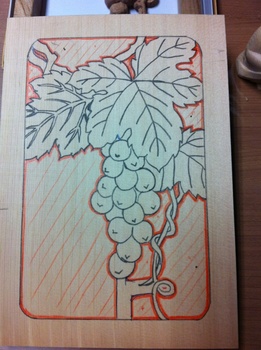
The next step is to remove excess of major parts roughly to make several levels (leaves, stems, fruit).
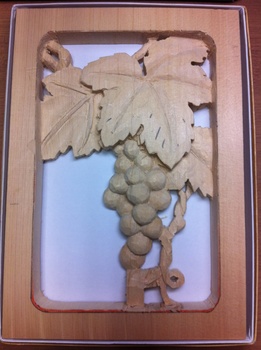
The third step is to make texture on each part.
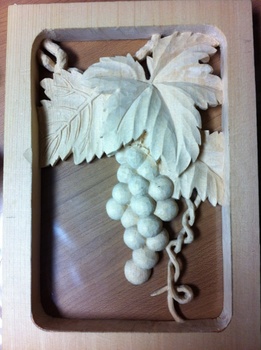
Isn't it beatiful?
First, we draw a rough sketch on a wood block, and cut out unnecessary parts one by one using a machine.

The next step is to remove excess of major parts roughly to make several levels (leaves, stems, fruit).

The third step is to make texture on each part.

Isn't it beatiful?
Carving a tiny statue of Ksitigarbha [Sculpturing]
Carving Buddha's hands [Sculpturing]
The third step is to carve Buddha's hands.
There are two basic hand shapes we will learn; close hand (握り手), open hand (開き手).
Here are my works. (Sorry, only close hands are available.)
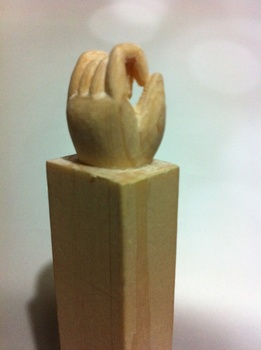
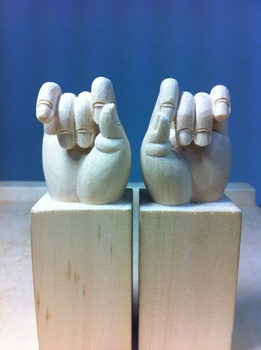
The close hand is for example for Kuanyin (観音) which holds a stem of Lotas. I would like to explain a little bit more about it next time.
There are two basic hand shapes we will learn; close hand (握り手), open hand (開き手).
Here are my works. (Sorry, only close hands are available.)


The close hand is for example for Kuanyin (観音) which holds a stem of Lotas. I would like to explain a little bit more about it next time.
Carving Buddha's foot [Sculpturing]
The second step is to carve Buddha's foot in the sculpturing class.
Before carving a full-length portrait of a Buddha's statue, we need to be familiar with how to carve body parts like hands and foot. After that, we learn how to carve heads (carving face is not easy).
Here is my work.
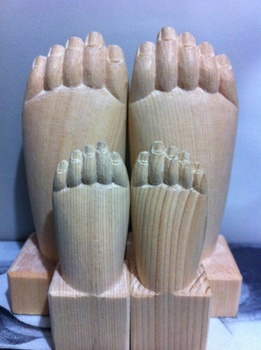
Unlike human's feet, th bottom of the feet is completely flat, and its shape is like baby's.
Before carving a full-length portrait of a Buddha's statue, we need to be familiar with how to carve body parts like hands and foot. After that, we learn how to carve heads (carving face is not easy).
Here is my work.

Unlike human's feet, th bottom of the feet is completely flat, and its shape is like baby's.
Carving a pattern where a flower in diamond is running [Sculpturing]
First, let me introduce the work to be done first in the sculpture class.
This pattern is called "地紋” (jimon) in Japanese. It has been very popular and thus seen in many pillars or pillar-stands or doors of old-time shrines or temples, furniture or stands for Buddha's statues, and on Japanese traditional clothings.
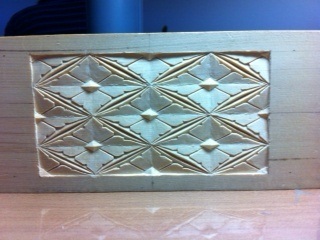
This pattern is called "地紋” (jimon) in Japanese. It has been very popular and thus seen in many pillars or pillar-stands or doors of old-time shrines or temples, furniture or stands for Buddha's statues, and on Japanese traditional clothings.

My favorite water-painting works [Waterpainting]
Here are some water-painting works I painted a several years ago.
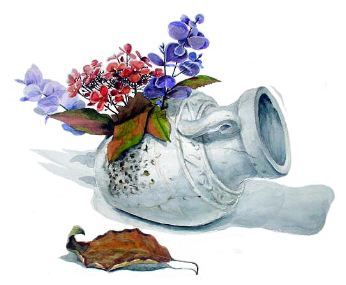
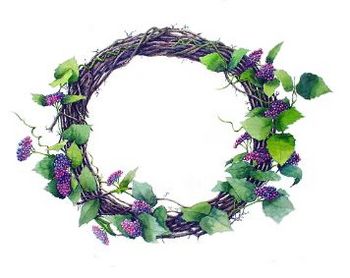
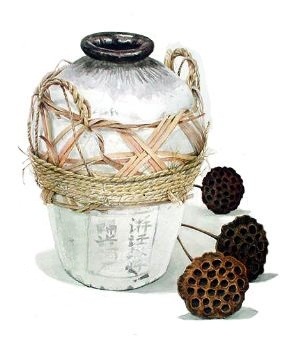
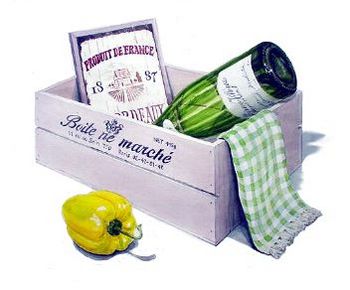
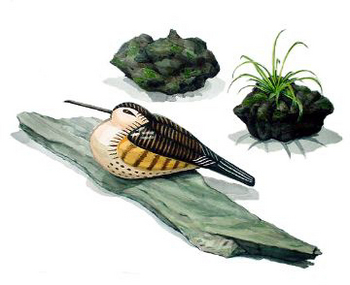
I went to a private atlier in Yokohama and learned water-painting on Saturdays for two years. This was before I started learning sculpturing.
They are not categorized as "traditional art" but learning waterpainting has become the base of my oil-paining based on the classical method in the 17th century in Europe.





I went to a private atlier in Yokohama and learned water-painting on Saturdays for two years. This was before I started learning sculpturing.
They are not categorized as "traditional art" but learning waterpainting has become the base of my oil-paining based on the classical method in the 17th century in Europe.
Welcome to my blog! [Introduction]
Welcome!
I am Yuca Ume, a Japanese living near Tokyo, Japan.
My family menbers are my husband (a telecommunications engineer) and two daughters (the elder one to be al nurse and the younger one studying hard to pass the next university entrance exam.).
For years, I have been engaged in writing and editing of various manuals for OA devices, and also directing of localization from English to 10 other languages.
Though doing the job, housekeeping and another thing at a time is tough and needs cooperation from my family, my husband encouraged me to start learning arts as he knows that I love arts.
From the beginning, I went to a sculputuring circle only two times a month (this is a general carriculum given to us). Later when the instructors established a school for learners who want to become professional, I decided to enter that school (night course). It was in September, 2010.
(The school is located near Naka-Meguro, Tokyo. If you are interested in it, please visit at http://www.sekikoun.jp/.)
The followig image shows the head of Kuanyin or 聖観音, and the head of Ksitigarbha or 地蔵菩薩. I carved them about three years ago before I had entered the school. I was facinated by the delicate surface of each carved trace and the beauty of their face. This step is the 6th or 7th in the beginner course.
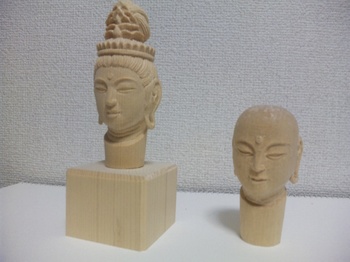
And now, I go to the night class two to three times a week. It is quite tough but refresh me and
In this blog, I would like to show you the process of each piece of work I did.
All I want you here is to feel interested in our Japanese traditional cultures and feel impressed with the beauty and completeness of sculpturing and also art is borderless and can make our mind rich.
I hope you will enjoy them.
One more challenge of mine is oil-painting. I joined a painting circle eight months ago. It was nearly miracle to have found my old teacher's painting class again. It was 15 years ago when I joined his painting class. For several years after the class, went to the States as a oilpainting conservation specialist. After that, I joined another class which taught me water-painting. I learned there for two years and switched this oil-painting class last year. The class is open mostly on Sundays usually three times per month. His webpage is http://www.basjp.com/.
The following is the latest image. This is Asura or 阿修羅, one of the eight guardian spirits in Buddha's world. It was originated from an ancient Indian religion and was also spread to other countries.
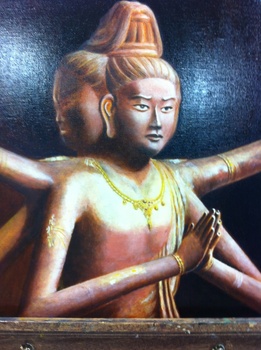
I am Yuca Ume, a Japanese living near Tokyo, Japan.
My family menbers are my husband (a telecommunications engineer) and two daughters (the elder one to be al nurse and the younger one studying hard to pass the next university entrance exam.).
For years, I have been engaged in writing and editing of various manuals for OA devices, and also directing of localization from English to 10 other languages.
Though doing the job, housekeeping and another thing at a time is tough and needs cooperation from my family, my husband encouraged me to start learning arts as he knows that I love arts.
From the beginning, I went to a sculputuring circle only two times a month (this is a general carriculum given to us). Later when the instructors established a school for learners who want to become professional, I decided to enter that school (night course). It was in September, 2010.
(The school is located near Naka-Meguro, Tokyo. If you are interested in it, please visit at http://www.sekikoun.jp/.)
The followig image shows the head of Kuanyin or 聖観音, and the head of Ksitigarbha or 地蔵菩薩. I carved them about three years ago before I had entered the school. I was facinated by the delicate surface of each carved trace and the beauty of their face. This step is the 6th or 7th in the beginner course.

And now, I go to the night class two to three times a week. It is quite tough but refresh me and
In this blog, I would like to show you the process of each piece of work I did.
All I want you here is to feel interested in our Japanese traditional cultures and feel impressed with the beauty and completeness of sculpturing and also art is borderless and can make our mind rich.
I hope you will enjoy them.
One more challenge of mine is oil-painting. I joined a painting circle eight months ago. It was nearly miracle to have found my old teacher's painting class again. It was 15 years ago when I joined his painting class. For several years after the class, went to the States as a oilpainting conservation specialist. After that, I joined another class which taught me water-painting. I learned there for two years and switched this oil-painting class last year. The class is open mostly on Sundays usually three times per month. His webpage is http://www.basjp.com/.
The following is the latest image. This is Asura or 阿修羅, one of the eight guardian spirits in Buddha's world. It was originated from an ancient Indian religion and was also spread to other countries.





